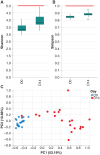Assessment of Antimicrobial Therapy in Eradicating Chlamydia muridarum in Research Mice: Immune Status and Its Impact on Outcomes
- PMID: 40035285
- PMCID: PMC11808367
- DOI: 10.30802/AALAS-JAALAS-24-069
Assessment of Antimicrobial Therapy in Eradicating Chlamydia muridarum in Research Mice: Immune Status and Its Impact on Outcomes
Abstract
Chlamydia muridarum (Cm) is a moderately prevalent, gram-negative, intracellular bacterium that affects laboratory mice, causing subclinical to severe disease, depending on the host's immune status. The effectiveness of various antibiotic regimens aimed at eradicating Cm in both immunodeficient and immunocompetent laboratory mice was evaluated. NSG mice were cohoused with Cm-shedding BALB/cJ mice for 14 d to simulate natural exposure. Four groups of 8 infected NSG mice were treated for 7 d with either 0.08% sulfamethoxazole and 0.016% trimethoprim (TMS) in water, 0.0625% doxycycline in feed, 0.124%/0.025% TMS in feed, or 0.12% amoxicillin in feed. A control group was provided standard water and feed. The impact of treatment on gastrointestinal microbiota (GM) was investigated using next-generation shotgun sequencing on the last day of treatment. TMS and amoxicillin had negligible effects on GM, while doxycycline had the largest effect. All antibiotic-treated NSG mice exhibited clinical disease, including dehydration, hunched posture, greater than 20% weight loss, and dyspnea, leading to euthanasia 21 to 40 d posttreatment (32.6 ± 4.2 d; mean ± SD). Untreated controls were euthanized 14 to 33 d postexposure (23.75 ± 5.9 d). All mice were fecal PCR positive for Cm at euthanasia. Histologic evaluation revealed multifocal histiocytic and neutrophilic bronchointerstitial pneumonia and/or bronchiolitis featuring prominent intralesional chlamydial inclusion bodies in all mice. Subsequently, groups of 8 C57BL/6J, BALB/cJ, NOD.SCID, and NSG mice infected with Cm were treated with 0.124%/0.025% TMS in feed for 7 (BALB/cJ and C57BL/6J) or 21 d (NSG and NOD.SCID). All immunocompetent and NOD.SCID mice were negative for Cm by PCR 14 d posttreatment, remained clinically normal, and had no evidence of Cm infection at necropsy, and all NSG mice remained Cm positive and were euthanized. While these findings highlight the difficulties in eradicating Cm from highly immunodeficient mice, eradication of Cm from immunocompetent or moderately immunocompromised mice with antibiotics is feasible.
Keywords: AB, aberrant body; B6, C57BL/6J; C, BALB/cJ; Cm, Chlamydia muridarum; DPT, days posttreatment; EB, elementary body; GEM, genetically engineered mouse; GM, gastrointestinal microbiota; IB, inclusion body; MOMP, major outer membrane protein; NOD.SCID, NOD.Cg-PrkdcscidIl2rgtm1Wjl/SzJ; NSG, NOD.Cg-Prkdcscid Il2rgtm1Wjl/SzJ; RB, reticulate body; SW, Tac:SW; TMS, trimethoprim and sulfamethoxazole.
Conflict of interest statement
The authors have no conflicts of interest to declare.
Figures





Update of
-
Assessment of Antimicrobial Therapy in Eradicating Chlamydia muridarum in Research Mice: Immune Status and its Impact on Outcomes.bioRxiv [Preprint]. 2024 Aug 10:2024.06.28.600682. doi: 10.1101/2024.06.28.600682. bioRxiv. 2024. Update in: J Am Assoc Lab Anim Sci. 2025 Jan 01;64(1):76-88. doi: 10.30802/AALAS-JAALAS-24-069. PMID: 38979332 Free PMC article. Updated. Preprint.
References
-
- American Veterinary Medical Association. 2020. AVMA guidelines for the euthanasia of animals: 2020 edition. Schaumburg (IL): AVMA.
-
- Barnes K, Steward J, Thwaite J, Lever M, Davies C, Armstrong S, Laws T, et al. 2013. Trimethoprim/sulfamethoxazole (co-trimoxazole) prophylaxis is effective against acute murine inhalational melioidosis and glanders. Int J Antimicrob Agents 41:552–557. - PubMed
MeSH terms
Substances
Grants and funding
LinkOut - more resources
Full Text Sources
Medical
Research Materials

